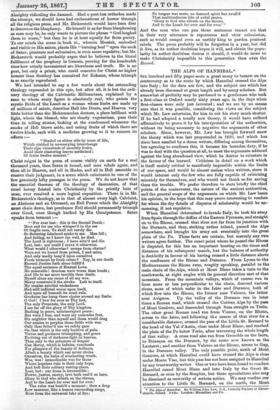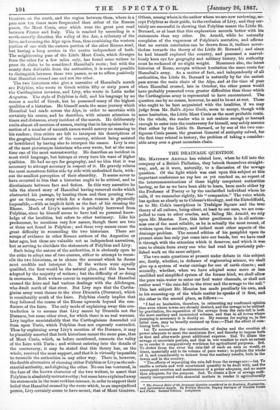THE ALPS OF HANNIBAL.*
Six hundred and fifty pages seem a great many to bestow on the controversy as to the route by which Hannibal crossed the Alps into Italy ; for the data are few, and the subject one which has already been discussed at great length and by many scholars. But somewhat of prolixity may be pardoned to a gentleman who took a first-class at Oxford nearly sixty years ago, in the days when first-classes were only just invented ; and we are by no means sure that it was possible, considering the views on the subject which Mr. Law entertains, for him to cut his story much shorter. If he had adopted a totally new theory, it would have sufficed affirmatively to prove it by his interpretation of the authorities, without its being necessary to negative the arguments of other scholars. Since, however, Mr. Law has brought forward anew the theory which was last propounded in 1820, and which has since been assailed by a dozen writers, differing among themselves, but agreeing to condemn this, it became his bounden duty, if he was to deal with the question at all, to meet the arguments adduced against the long abandoned view, which he desires to reinstate in the favour of the learned. Criticism in detail on a work which is itself mainly critical is manifestly impossible within the limits of our space, and would be almost useless when written,- since it would interest only the few who are fully capable of criticizing minutely for themselves, and who would not thank us for saving them the trouble. We prefer therefore to state briefly the chief points of the controversy, the nature of the ancient authorities, and the general scope of the arguments on which Mr. Law bases his opinion, in the hope that this may prove interesting to readers for whom the dry details of disputes of scholarship would be un- meaning, if not repulsive.
When Hannibal determined to invade Italy, he took his army from Spain through the defiles of the Eastern Pyrenees, and straight on to the Rhone, crossed that river not far from its junction with the Durance, and then, striking rather inland, passed the Alps somewhere, and brought his army out eventually into the great plain of the Po. These facts are certain, but scarcely any two writers agree further. The exact point where he passed the Rhone is disputed, for this has an important bearing on the times and distances of his subsequent march, but the balance of authority is decidedly in favour of his having crossed a little distance above the confluence of the Rhone and Durance. From Lyons to the Mediterranean the Rhone runs, roughly speaking, parallel to the main chain of the Alps, which at Mont Blanc takes a turn to the southwards, at right angles with its general direction east of that mountain. From the mountain valleys, which of course run in lines more or less perpendicular to the chain, descend various rivers, most of which unite in the Isere and Durance, both of which flow into the Rhone, the former near Valence, the latter near Avignon. Up the valley of the Durance ran in later times a Roman road, which crossed the Cottian Alps by the pass of Mont Genevre, and descended through Susa straight on Turin. The other great Roman road ran from Vienne, on the Rhone, across to the Isere, and following the course of that river for a considerable distance, crossed the pass of the Little St. Bernard to the head of the Val d'Aosta, close under Mont Blanc, and reached the plain of the Po below Turin, after traversing the whole length of that valley. A cross road also ran from Grenoble on the Isere, to Briancon on the Durance, by the route now known as the Lautaret ; and another from Valence on the Rhone, across to Gap, in the Durance valley. The only possible point, south of Mont Genevre, at which Hannibal could have crossed the Alps is close under Monte Viso, but this pass has not been assigned to Hannibal by any trustworthy writer. One or two have been found to conduct Hannibal round Mont Blanc and into Italy by the Great St. Bernard, or even by the Simplon, but these speculations also may be dismissed as unworthy of serious notice. We may confine our attention to the Little St. Bernard, on the north, the Mont
• The Alps of Hannibal. IIy William John Law, MA., formerly Slalom of Christ- church, Oxford. 2 'rola. Loudon: Macmillan and Co.
Genevre, on the south, and the region between them, where is a pass now ten times more frequented than either of the Roman passes, the Mont Cenis, over which runs the great post road between France and Italy. This is reached by ascending in a south-easterly direction the valley of the Arc, a tributary of the Isere, and crossing the Alps upon Sum, thus combining the western portion of one with the eastern portion of the other Roman road, but having a long section in the centre independent of both. The neighbouring pass of the Little Mont Cenis, which diverges from the other for a few miles only, has found some writers to press its claim to be considered Hannibal's route ; but with the scanty data derivable from the authorities, it is scarcely possible to distinguish between these two passes, so as to affirm positively that Hannibal crossed one and not the other.
The two historians who give a narrative of Hannibal's march are Polybius, who wrote in Greek within fifty or sixty years of the Carthaginian invasion, and Livy, who wrote in Latin under Augustus. The style of Polybius is dull, and his language by no means a model of Greek, but be possessed many of the highest qualities of a historian. He himself made the same journey which Hannibal had made across the Alps, in order to ascertain with certainty his course, and he describes, with minute attention to times and distances, every incident of the march. He deliberately omits almost all mention of names, stating that in his opinion the in- sertion of a number of uncouth names would convey no meaning to his readers ; thus critics are left to interpret his descriptions of the geographical features of the country, without being assisted or bewildered by having also to interpret the names. Livy is one of the most picturesque historians who ever wrote, but at the same time one of the most untrustworthy. He describes an incident in most vivid language, but betrays at every turn his want of higher qualities. He had no eye for geography, and no idea that it was necessary to attempt accuracy in respect of it. He gravely relates the most monstrous fables side by side with undoubted facts, with- out the smallest perception of their absurdity. It seems never to have occurred to him that a historian ought to be critical, and to discriminate between fact and fiction. In this very narrative he tells the absurd story of Hannibal having removed rocks which obstructed his passage, by heating them and then pouring vine- gar on them,—a story which for a dozen reasons is physically impossible,—with as implicit faith as the fact of his crossing the Rhone. Much of Livy's narrative is probably borrowed from Polybius, since he himself seems to have had no personal know- ledge of the localities, but refers to other testimony. Like his predecessor, he mentions very few names, though there are two or three not found in Polybius ; and these very names cause the great difficulty in reconciling the two historians. There are scraps of evidence in other Roman authors of the Augustine or later ages, but these are valuable not as independent narratives, but as serving to elucidate the statements of Polybius and Livy.
Such being the nature of the authorities, it is obviously open to the critic to adopt one of two courses, either to attempt to recon- cile the two historians, or to choose the account which he deems most credible and interpret it. If the writers were equally qualified, the first would be the natural plan, and this has been adopted by the majority of writers ; but the difficulty of so doing is enormous. Both writers concur in representing that Hannibal crossed the Isere and had various dealings with the Allobroges, who dwelt north of that river. But Livy says that the Cartha- ginian army went thence to the river Druentia (Durance), which is considerably south of the Isere. Polybius clearly implies that they followed the course of the Rhone upwards beyond the con- fluence of the Isere. The only mode of explaining away this con- tradiction is to assume that Livy meant by Druentia not the Durance, but some other river, for which there is no real warrant. Livy implies unmistakably that the Carthaginians descended via Sum upon Turin, which Polybius does not expressly contradict. Thus by explaining away Livy's mention of the Durance, it may be plausibly asserted that both historians meant the same pass, that of Mont Cenis, which, as before mentioned, connects the valley of the Isere with Turin ; and without entering into the details of the controversy, it may be stated that this theory has, on the whole, received the most support, and that it is virtually impossible to reconcile the authorities in any other way. There is, however, the double alternative of choosing either Polybius or Livyas the sub- stantial authority, and alighting the other. No one has ventured, in the face of the known character of the two writers, to assert that Polybius is absolutely untrustworthy; but some have explained away his statements in the most reckless manner, in order to support their belief that Hannibal crossed by the route which, to an unprejudiced person, Livy certainly seems to have meant, that of Mont Genevre. Others, among whom is the author whom we are now reviewing, ac- cept Polybius as their guide, to the exclusion of Livy, and they cer- tainly are successful in showing that Polybius meant the Little St. Bernard, or at least that this explanation accords better with his statements than any other. Dr. Arnold, while be naturally complains of the vagueness of Polybius's narrative, and affirms that no certain conclusion can be drawn from it, inclines never- theless towards the theory of the Little St. Bernard ; and since he had himself explored the country, and possessed a marvel. lously keen eye for geography and military history, his authority must be reckoned of no slight weight. Mommsen also, the latest historian of Rome, accepts without hesitation the same route for- Hannibal's army. As a matter of fact, and independently of all authorities, the Little St. Bernard is naturally by far the easiest pass across the main chain of the Alps, and at the time of year- when Hannibal crossed, late in October, the other passes would have probably presented even greater difficulties than those which the Carthaginian army is represented to have encountered. The question can by no means, however, be said to be set at rest. Those who ought to be best acquainted with the localities, if we may judge from Mr. Ball's Alpine Guide, seem to accept, though with some hesitation, the Little Mont Cenis as the most probable route. On the whole, the reader who is not zealous enough or learned enough to enter into the controversy for himself, may safely assume- that either by the Little St. Bernard, or by one of the two con- tiguous Cenis passes, the greatest General of antiquity solved, for- the first time related in history, the problem of taking a consider- able army over a great mountain chain.































 Previous page
Previous page